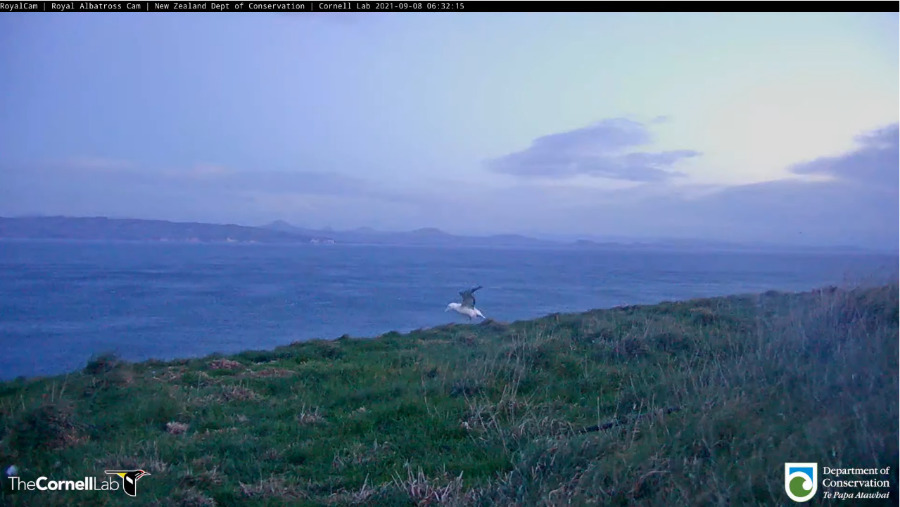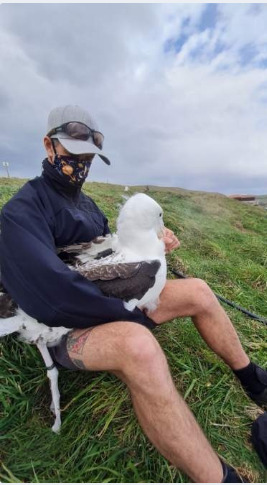LGK nāk vēlreiz.

16.46
Meitiņa seko un vienīgā doma - ēst.

16.47
Meitiņa mēģina izdīkt ēdamo,bet tētis (tā man liekas)cenšas pastāstīt ,ka ir ļoti noguris.

Sharyn Broni (Ranger, DOC)Sharyn Broni (Ranger, DOC) Mod
Kia ora koutou (hello everyone)
Today Tiaki is 226 days old and weighs 9.4kg. LGKs trip to the Tasman Sea seems to have increased her weight. She was later fed by LGL at 12.45.
The chicks are now all fairly mobile with some moving up to 100m from their nest areas. We have also had our first fledging, with Quarry chick not being found anywhere on the headland today. She is one of the older chicks at 229 days of age.
The new season for 2021/22 has also begun with the arrival of a new seasons adult, banded YL today by Colin. I will provide more details at a later stage.
Fun Fact for the end of level 3 lockdown in this area: RLK (SSTrigs dad) is the sibling of Atawhai, last years Royalcam chick. Their parents (OGK and YRK) are due back in October for the next breeding season.
It might be another week or two yet, but soon we will start to see the early arrivals for the next breeding season. They will have pale bills and be plumper than the current parents who now need a year off from breeding.
Meanwhile, the chicks of 2021 are getting ready to fledge by practicing with their wings and by bring up hard parts of the food that cannot be digested. This bolus, likely from SSTrig contained two squid beaks.





Sharyn Broni (mežzinis, DOC) ModSharyn Broni (Ranger, DOC) Mod
Kia ora koutou (hello everyone)
Today, after 1pm Tiaki will receive a GPS tracker like the one LGK has. She will be the only chick in this colony to receive one.
Tiaki is 228 days of age today and her fledging day should be within the next couple of weeks.
Later today I will have more news about the bell ringing which is on Monday 13th September 2021.
GT tulkojums:Sharyn Broni (Ranger, DOC) Mod
Kia ora koutou (hello everyone)
A wider study of the entire Northern Royal Albatross is being conducted this year. And in a first for a Royalcam chick Tiaki as received a tracker.
Trackers have deployed on northern royals on the Chathams where 99% of the world population of this species breeds.
We are extremely lucky to have 20g devices are available to track LGK, LGL and Tiaki. Although LGL's device failed it has provided valuable data.
Devices are extremely light compared to the weight of the bird and attached to back feathers. These feathers molt within a year and the device will fall off. The device is solar powered and will remotely send data until molting.
Experienced researchers from Parker Conservation deployed the device for Tiaki today.
We will have more information soon and will post a highlight clip post device deployment. Her tracking data will show up on the same page as LGKs tracking data:
It is natural for the albatross to preen around the area of the device as some ruffling of feathers is unavoidable during this process. It is, or course, a change for them to have a device on their backs and it will come off in around a year when these particular feathers molt.
The devices are transmitting a data point every 40 minutes during the day and every 2 hours during the night. They are solar powered so power conservation is necessary at night.
A comparison between Chathams and Taiaroa albatross could be informative.
Changes in climate, prey location, and fishing activity are likely to affect these birds. Solid data is required to affect future decision making in these areas.
Off camera: Albatross at sea from: https://www.doc.govt.nz/nat...
Once chicks fledge, they’ll live at sea for 4 – 10 years. Non-breeding birds who have been socialising on the headland leave for sea by the end of May.
A life of soaring
On Royal Cam you’ll see chicks practice soaring. You’ll hold their wings out facing the wind and hover above the ground to learn how to take off and land. Once fledged, albatross use a technique known as ‘dynamic soaring’.
Dynamic soaring is when an albatross repeatedly turns into the wind to travel forwards. They turn into the wind current to gain about 30 m in height above sea level, then dive downwards to gain forward momentum. Studies have recorded them reaching speeds of over 100 km per hour (or 67 miles per hour) while doing this and enabling them to fly 1,000 km a day without flapping their wings.
By using this technique, they use the same energy they would while sitting, whereas flapping uses 15 times more. So, albatross can fly thousands of kilometres each week and over 10,000 km in a single journey.
Eating and sleeping at sea
When albatross leave the headland for the winter, they go to feed off the coast of South America. They spend many years at sea and sleep on the ocean rather than on land. Albatross land and sleep on the ocean for several hours at a time.
Feeding from the surface of the ocean, they use the hook on the end of their beak and its sharp edges to spear and break down food. They can open their mouths beyond their beak to swallow large bites of over 1 kg in size.
The birds will target anything on the water’s surface or just below that looks or smells like food. Because of this, plastic pollution is an enormous problem for albatross. Algae growing on the plastic smells like their food and if they eat this continually, it can cause them to starve.




Sharyn Broni (Ranger, DOC) ModSharyn Broni (Ranger, DOC) Mod
Kia ora koutou (hello everyone)
There are 26 chicks remaining on the headland today. They are either down the hill or to the right of the Hcam as the very strong winds are coming from the north today. One left this afternoon, check out the Royal Albatross Centre's facebook page later on as one of the guides captured a video of one flying over the harbour entrance towards the Pacific Ocean.
Albatross will fly into the wind before using dynamic soaring to bank and turn into the direction they want to go in.
We have some blips in the data from Tiaki's GPS tag at the moment. She has not fledged. Once a chick fledges they head out to the ocean and we typically do not see them for the next 5 years.
Average fledging age is 240 days, the 3 who have fledged (Quarry, Quarry Track and 2 from down at the bottom of the hill were 223 - 231 days of age on fledging, this is on the early side but certainly not unheard of) Tiaki is 231 days of age today.
https://my.wildlifecomputer...
Occasionally we may rescue a chick who has landed on a flat beach or the harbour where they cannot easily take off from. In these cases they are bought back to the headland to try again.
I'll be sharing todays pics of her on Tuesday's update along with some messages from Room 4, Whitau School.
Bell ringing to celebrate the arrival of the first albatross in for the 2021/22 season will be on Monday 13th September 1pm NZST
We are experiencing some technical issues with the cam controls although we are still live streaming. We are unable to pan and zoom as normal but hope to have this issue fixed soon.




(GT tulkojums)Sharyn Broni (Ranger, DOC) Mod
Kia ora koutou (hello everyone)
A bolus was regurgitated by Tiaki on cam at 4.28am NZST this morning. Her fledging time is not far away. Her other neighbour, South Plateau chick has fledged.
Taiki on Sunday morning.
Tiaki was weighed this morning, as were all the remaining chicks on the headland. (I do not have specific numbers at this point as several chicks have fledged since Sunday.) Tiaki is 233 days of age and weighed in at 8kg so definitely within the zone of fledging. No weight to report from SSTrig chick as she fledged on Sunday.
Here is SSTrig chick on Sunday morning. The concrete structure behind her is the top of the Disappearing Gun Pit, the underground Fort can be visited through tours with the Royal Albatross Center. This area is beyond the far right of the Hcam view.
Check out LGK and Tiaki's GPS data here.
https://my.wildlifecomputers.com/data/m ... 139976bcfe
We have kept in Tiaki's apparent trips away from the headland as to remove these would also remove LGK's trip around the bottom of the South Island.
We received some lovely mail from Whitau School in Christchurch, here are their messages and a couple of the drawings they sent in.
This is early, in many years this celebration is towards the end of fledging.
Other news
We are continuing to have issues with operating the cam for panning and zooming but a replacement unit that lets the cam talk to the computer has been ordered. We will resume normal cam operations when the new unit has been installed. Thank you for your patience, at least the live stream is still functioning.
I will be away till Sunday so if Tiaki fledges during this time you will be hearing from other Department of Conservation staff with this news. Apologies for not being able to answer your questions during this time. We will not be reporting on every chick fledging but will provide an update once fledging has finished.
(GT)Sharyn Broni (Ranger, DOC) Mod
Just a note regarding GPS data from the technical team:
Satellite transmitters like the one deployed on Tiaki can transmit locations that can have some errors associated with them. Errors associated with the locations can arise due to multiple factors (eg. direction and duration of satellite passes, communication with satellites during the pass etc.). This means that a given transmitter can transmit very good locations (error radius less than 30m) and very bad locations (error radius with over 100km) all within the same day.
All transmitted locations are filtered through an algorithm to retain locations that have acceptable error radius (<10Km).Only these filtered locations are displayed on the map. This amount of error is deemed acceptable as these errors are insignificant when compared to the distance these birds can travel in a year.
Locations from Tiaki’s tag is currently looking hugely erroneous as the map view is zoomed in to a very small area (the most error associated with Tiaki’s locations so far is ~5.8 km). This amount of error will become inconspicuous once she fledges.
Fledging update: 21 chicks remain on the headland.
To remove Tiaki's erronous errors would also mean removing LGK's data and have it look like he crossed the South Island rather than going around. We will leave the data as is for now.